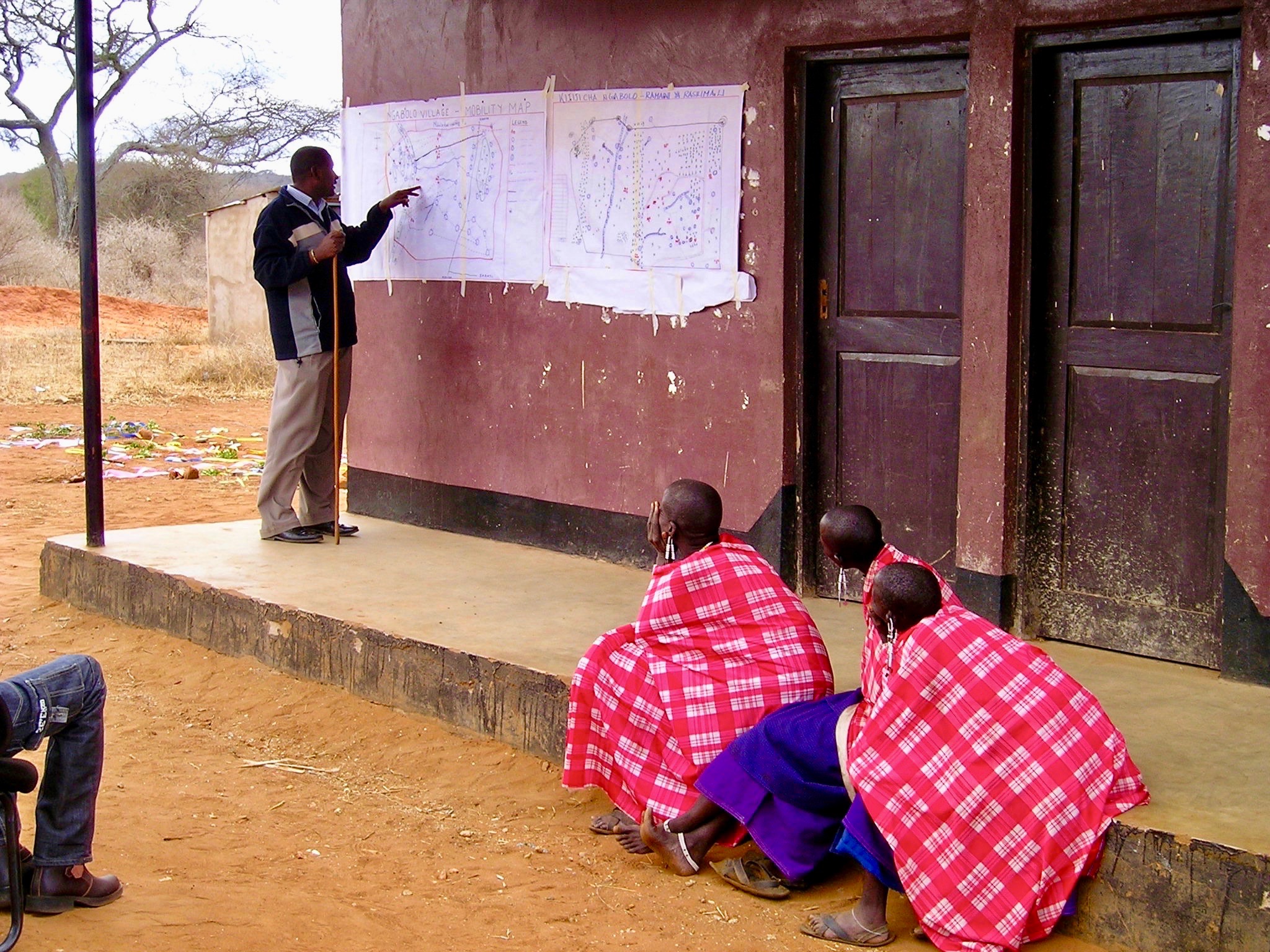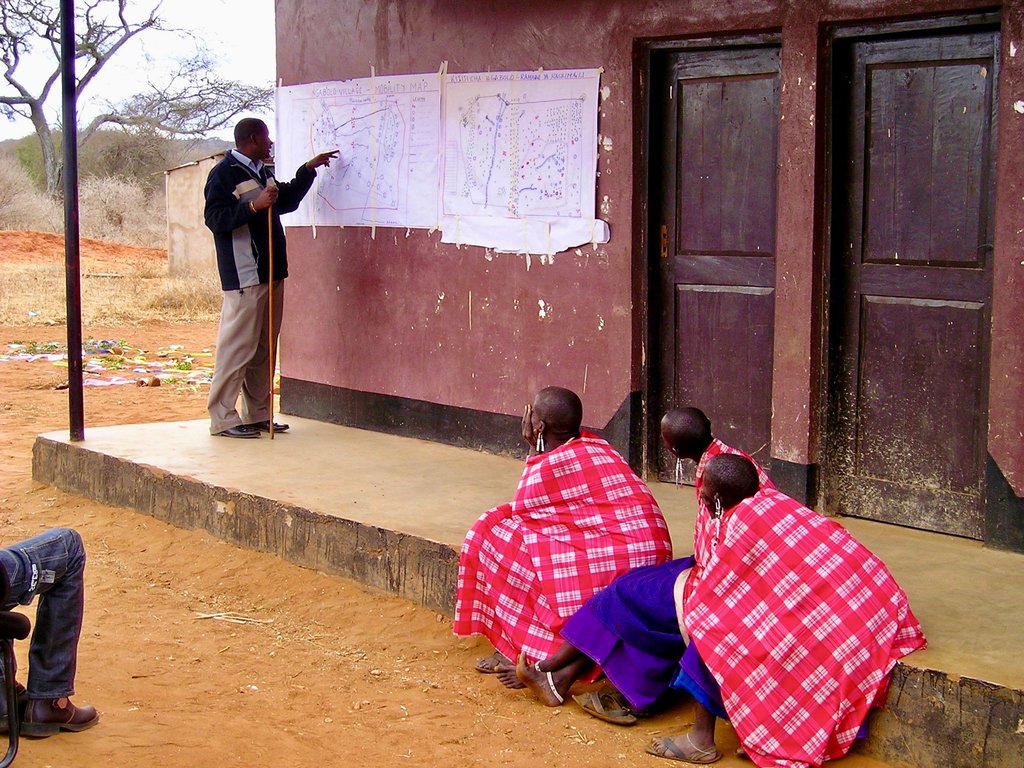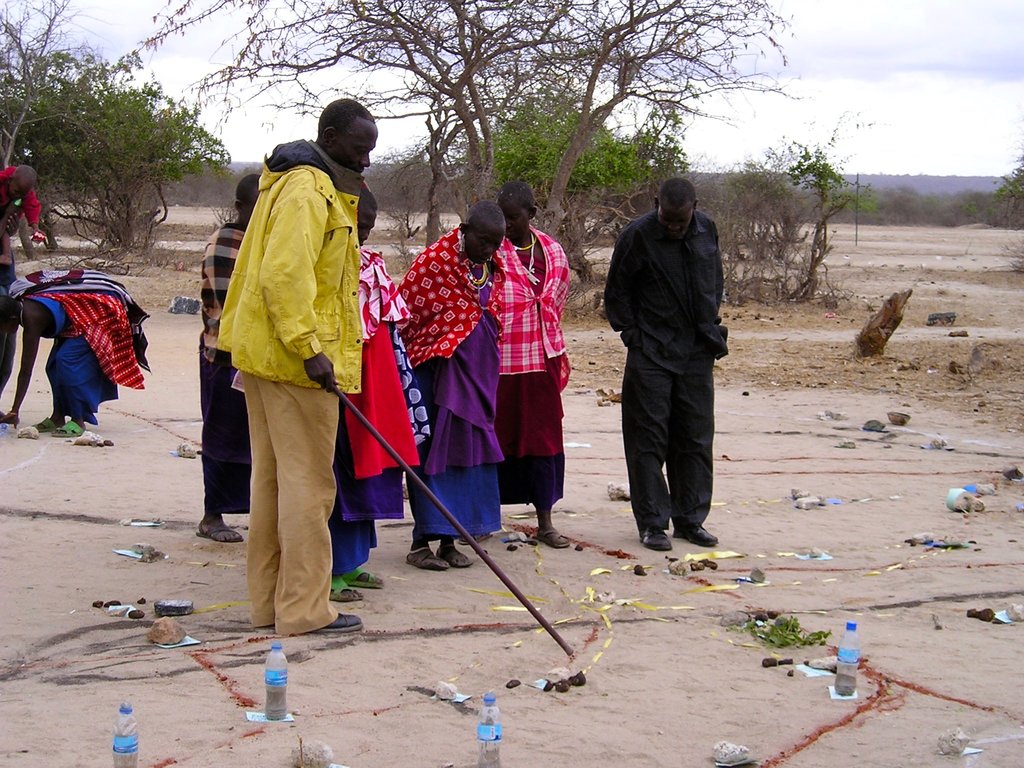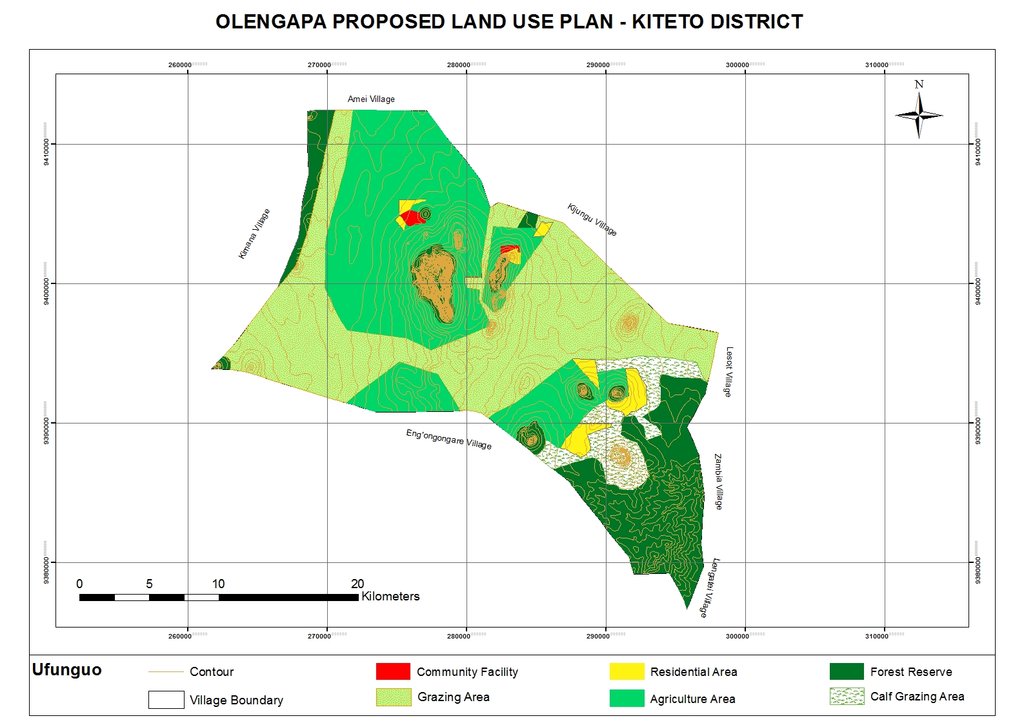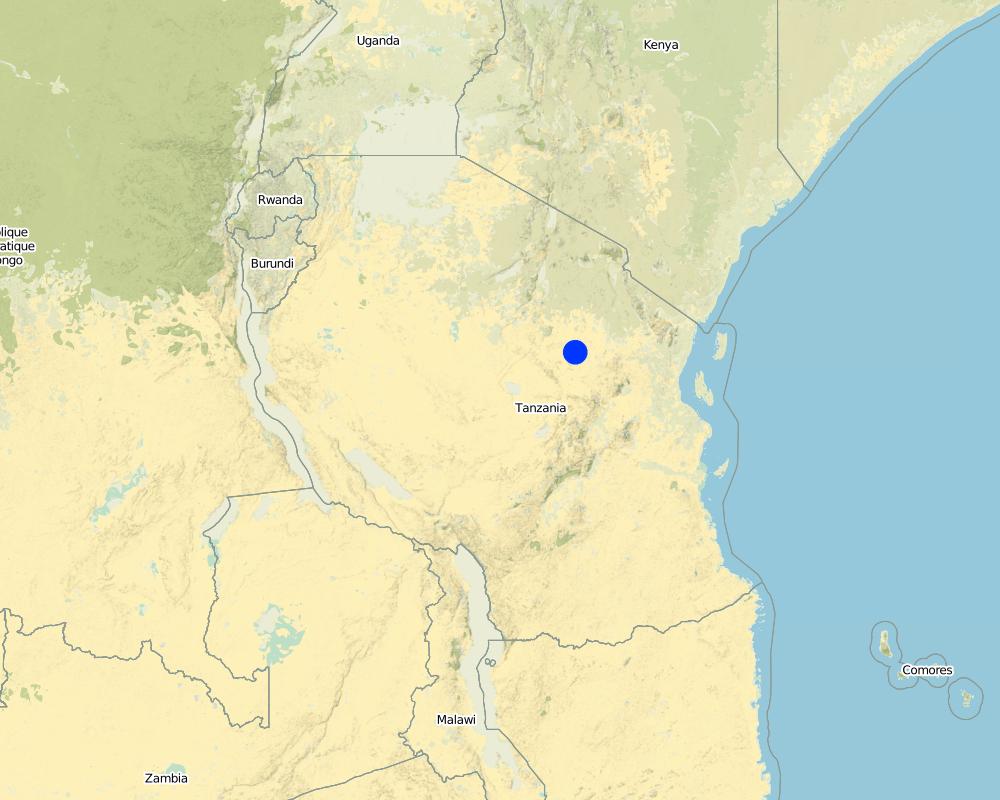Joint village land use planning [تنزانيا، جمهورية تنزانيا المتحدة]
- تاريخ الإنشاء:
- تحديث:
- جامع المعلومات: Fiona Flintan
- المحرر: –
- المُراجع: Rima Mekdaschi Studer
approaches_3336 - تنزانيا، جمهورية تنزانيا المتحدة
عرض الأقسام
توسيع الكل طي الكل1. معلومات عامة
1.2 تفاصيل الاتصال بالأشخاص الرئيسيين لمصدر المعلومات والمؤسسات المعنية بتقييم وتوثيق النهج
اسم المشروع الذي سهّل توثيق/تقييم النهج (إذا كان ذلك على صلة)
Sustainable Rangeland Management Project (ILC / ILRI)اسم المؤسسة (المؤسسات) التي سهلت توثيق/تقييم النهج (إذا كان ذلك على صلة)
ILRI International Livestock Research Institute (ILRI) - كينيا1.3 الشروط المتعلقة باستخدام البيانات الموثقة من خلال WOCAT
متى تم تجميع البيانات (ميدانيا)؟:
30/11/2016
يوافق جامع المعلومات والشخص (لاشخاص) الرئيسي لمصدر المعلومات على الشروط المتعلقة باستخدام البيانات الموثقة من خلال WOCAT:
نعم
2. وصف نهج الإدارة المستدامة للأراضي
2.1 وصف موجز للنهج
Joint village land use planning is a process facilitated by Tanzania's land policy and legislation. It supports the planning, protection and management of shared resources across village boundaries. It is an important tool towards land use planning and better rangeland management. This case study provides an example from a cluster of villages in Kiteto District, Tanzania.
2.2 وصف تفصيلي للنهج
وصف تفصيلي للنهج:
The Sustainable Rangeland Management Project (SRMP) is an initiative led by Tanzania’s Ministry of Livestock and Fisheries (MoLF), the International Livestock Research Institute (ILRI) and the National Land Use Planning Commission (NLUPC), with support from International Fund for Agricultural Development (IFAD), Irish Aid and the International Land Coalition (ILC). A key innovation of the project has been the development of joint village land use planning (JVLUP). The JVLUP process in Kiteto District, Manyara Region began in November 2013, and included the villages of Lerug, Ngapapa, and Orkitikiti. The three villages share boundaries and grazing resources, and in order to illustrate a single shared identity across the boundaries, the name OLENGAPA was chosen - incorporating part of each village’s name.
The total area of the three villages is (approx.) 59,000 hectares. The majority of inhabitants are Maasai pastoralists with some Ndorobo hunter-gatherers, and some farmers - most of whom are seasonal migrants. Mobility is central to the survival of the pastoralists and takes place across the three villages, as well as to locations in Kilindi, Gairo, and Bagamoyo Districts.
Average annual rainfall is between 800-1,000 mm per annum. There are no perennial rivers flowing through the OLENGAPA villages. The only permanent surface water source is Orkitikiti Dam, constructed in 1954.
In order to understand the different resources such as grazing areas, water points, cropping areas, livestock routes, and cultural places, SRMP supported participatory mapping. This assisted in developing a base map for the village land use planning process: it showed which resources were shared by the villages and where they were situated.
SRMP then helped village members to agree the individual village land use maps and plans - which zoned the village land into priority land uses - as well as the joint village land use map and plan, and the joint village land use agreement (JVLUA). These specified the grazing areas, water points, livestock routes and other shared resources. Reaching agreement was a protracted negotiation process between the villages, and within villages also - between different interest groups. It involved numerous community meetings and considerable investment of resources. Finally, each Village Assembly approved the JVLUA, which allocated approx. 20,700 ha of land for shared grazing –around 40% of the total village area. By-laws for management of the resources were developed and adopted.
Following approval of the JVLUA, the three OLENGAPA Village Councils established a Joint Grazing Land Committee made up of members from all three villages. This Committee is responsible for planning, management, enforcement of by-laws applicable to the OLENGAPA, and coordination of the implementation of both the OLENGAPA land use agreements and joint land use plan. In addition, a Livestock Keepers Association was established, including 53 founding members – but with most households from the three villages being associate members. A constitution was developed for the Association, which was officially registered on 11 September 2015.
In January 2016 the Ministry of Lands approved and registered the village land boundary maps and deed plans for the three villages. The District Council has issued the village land certificates, and the next step is for Village Councils to begin issuing Certificates of Customary Rights of Occupancy (CCROs). The shared grazing area will require three group CCROs to be issued to the Livestock Keepers Association – one from each village - for the part of the grazing area that falls under its jurisdiction. Signboards and beacons marking the shared grazing area are being put in place.
In November 2017 a fourth village joined OLENGAPA, expanding the shared grazing area to 30,000 ha. The villages are now working to develop a management plan to improve rangeland productivity.
2.3 صور عن النهج
2.5 البلد/المنطقة/المواقع التي تم تطبيق النهج فيها
البلد:
تنزانيا، جمهورية تنزانيا المتحدة
المنطقة/الولاية/المحافظة:
Manyara Region
مزيد من التفاصيل حول الموقع:
Kiteto District
التعليقات:
Kiteto District, Manyara Region, Tanzania
Map
×2.6 تواريخ بدء وإنهاء تنفيذ النهج
أشر إلى سنة البدء:
2010
سنة الإنهاء (إذا لم يعد النهج مطبقًا):
2017
2.7 نوع النهج
- قائم على مشروع/برنامج
2.8 الغايات/الأهداف الرئيسية للنهج
To secure shared grazing areas and other rangeland resources for livestock keepers, and to improve their management.
2.9 الظروف التي تمكن أو تعيق تنفيذ التقنية/التقنيات المطبقة بموجب النهج
المعايير والقيم الاجتماعية /الثقافية/ الدينية
- تمكين/تمكيني
History of collective tenure, management and sharing of rangeland resources as part of sustainable rangeland management practices.
- معيق
Marginalisation of pastoralists from decision-making processes at local and higher levels.
توفر/الوصول إلى الموارد والخدمات المالية
- معيق
Village land use planning process is costly due to the requirement to include government experts in the process in order to gather required data and to authorise plans. Lack of government priority to village land use planning, so poor allocation of government funds to the process.
الإطار المؤسساتي
- تمكين/تمكيني
Strong local government/community institutions for leading process at local albeit their capacity may require building.
التعاون/التنسيق بين الجهات الفاعلة
- معيق
Poor coordination of different actors supporting VLUP in the past due to previous weakness of National Land Use Planning Commission (NLUPC). However, this is now changing as NLUPC becomes stronger and takes up coordination role.
الإطار القانوني (حيازة الأراضي، وحقوق استخدام الأراضي والمياه)
- تمكين/تمكيني
Tanzania's legislation, if implemented well, provides an enabling environment for securing of community/village rights for both individuals and groups.
- معيق
Legislation allows village land to be transferred into public land if in the "public" or "national" interest - this facility confers insecurity on village land.
السياسات
- تمكين/تمكيني
Tanzania possesses facilitating national land use policy for the joint village land use planning approach, together with guidelines.
- معيق
There are conflicting policies over land coming from different sectors including land generally, together with forests, wildlife and livestock. These cause confusion at the local level. Depending on power of actors one set of policies may be stronger than another - wildlife-related policy for example can have a lot of power because there are many strong and influential tourism and conservation bodies lobbying for stronger protection of land, with potentially negative impacts for communities who want to use that land for other purposes.
حوكمة الأراضي (صنع القرار والتنفيذ والإنفاذ)
- تمكين/تمكيني
Decision-making has been decentralised to the lowest levels, giving local communities considerable power to decide on the uses of their village land.
- معيق
The process of village land use planning is costly due to the requirement for having local government experts involved, and the need to follow often complex procedures and steps. Many communities and even local government do not have adequate technical skills and knowledge to complete the long process, as well as not having adequate funds. This has held up the VLUP applications. Further few VLUPs move from their production stage to implementation stage including enforcement of bylaws and, for example, land management.
المعرفة حول الإدارة المستدامة للأراضي، والوصول إلى الدعم الفني
- تمكين/تمكيني
Good local knowledge of rangeland management based on historical practice. Communities understand need for better rangeland management.
- معيق
Lack of investment in rangeland management and the provision of technical support e.g. through government extension services. Lack of technical knowledge in rangeland rehabilitation and improving rangeland productivity at scale.
الأسواق (لشراء المدخلات وبيع المنتجات) والأسعار
- معيق
Lack of local markets and coordinated operations for livestock production.
عبء العمل، توفر القوى العاملة
- تمكين/تمكيني
Well-structured local community bodies ready to provide manpower. Local government experts in place to support VLUP process.
- معيق
Lack of knowledge, skills and capacity amongst local communities and government experts to complete JVLUP adequately, including such as resolving conflicts between different land users.
3. المشاركة وأدوار الأطراف المعنية
3.1 أصحاب المصلحة المعنيون بالنهج وأدوارهم
- مستخدمو الأراضي المحليون/المجتمعات المحلية
Village members (Assembly) of three villages - Orikitiki, Lerug and Ngapapa.
All village members as the Village Assembly have an opportunity to contribute to the land use planning process and to approve it.
- المنظمات المجتمعية
Village Council, Village Land Use Management Committee (VLUMC), Rangeland Management Committee, Livestock Keepers Association.
Village government coordinated the planning process at local level. VLUMC develops plan. Village Council approves plans and issues CCROs. Rangeland Management Committee oversees development in rangelands. Livestock Keepers Association established made-up of all members of the villages that have livestock (nearly all village members) - they will be issued with CCROs as "owners" of the grazing land.
- متخصصون في الإدارة المستدامة للأراضي / مستشارون زراعيون
Land use planning consultants
Provision of advice to the project team, local government and villagers on the JVLUP approach.
- الباحثون
International Livestock Research Institute (ILRI)
Identification of good practice in village land use planning in Tanzania and ways to adapt and incorporate good practice into joint village land use planning to improve the approach. Research on role of and impact on pastoral women. Undertaking of baseline studies.
- منظمة غير حكومية
KINNAPA Development Association (supported originally by CARE and Tanzania Natural Resource Forum).
KINNAPA is the local CSO partner working as part of the project to implement the JVLUP with local communities
- الحكومة المحلية
District Council including the PLUM (participatory land use management planning experts)
The District Council provides local government oversight of the planning process and approves the plan before submitting to national government body. The PLUM technically supports the development of the JVLUP working with the village government(s) and village committees.
- الحكومة الوطنية (المخططون، صانعو القرار)
Ministry of Livestock and Fisheries, National Land Use Planning Commission (NLUPC), Ministry of Lands, Housing and Human Settlements Development,
Ministry of Livestock and Fisheries leading the planning process with a sectoral interest in protecting rangelands. NLUPC provides technical oversight and guidance. Ministry of Lands is the national body that approves the final plan.
- منظمة دولية
International Land Coalition (ILC)
ILC is the grant recipient for the funds from the donors. The project is implemented through ILC members such as ILRI. ILC coordinates its members work in Tanzania on land issues including the JVLUP through a national engagement strategy (NES). ILC also provides technical support to the process through its global/Africa programme - the ILC Rangelands Initiative. The ILC Rangelands Initiative is a platform for learning, sharing, influencing, and connecting on rangeland issues with the objective of making rangelands more secure.
- Donors
IFAD and Irish Aid
Provide funds for the project. IFAD also provides technical support on land tenure issues.
إذا كان هناك العديد من الأطراف المعنية، قم بالإشارة إلى الوكالة الرائدة:
The lead agency is the International Land Coalition (ILC) working through its members including ILRI. In country, the main implementer is the Ministry of Livestock and Fisheries
3.2 انخراط مستخدمي الأراضي المحليين/المجتمعات المحلية في المراحل المختلفة للنهج
| انخراط مستخدمي الأراضي المحليين/المجتمعات المحلية | حدد من شارك وصف الأنشطة | |
|---|---|---|
| المبادرة/التحفيز | الدعم الخارجي | The project supported communities to initiate the first steps taken to reach agreement on the need for planning and how this would be done. |
| التخطيط | تفاعلي | Communities were centrally involved in the planning of the VLUP process, with support from local NGO and government. |
| التنفيذ | تفاعلي | Village government and community in general is responsible for the implementation of the planning process, with the support of local government. |
| الرصد/التقييم | الدعم الخارجي | The community is responsible for monitoring and evaluation, but lack skills and capacity in this regard requiring external support. |
| Research | الدعم الخارجي | Research on information required for planning processes collected and generated by communities with the assistance of technical support from local NGO, local government and researchers. |
3.3 مخطط التدفق (إذا كان متاحًا)
3.4 اتخاذ القرار بشأن اختيار تقنية/تقنيات الإدارة المستدامة للأراضي
حدد من الذي قرر اختيار التقنية/التقنيات التي سيتم تنفيذها:
- جميع الجهات الفاعلة ذات الصلة، كجزء من نهج تشاركي
اشرح:
The policy and legislation lays down the steps to be followed for the VLUP/JVLUP process. However there is room to adapt these processes to local context - and here all stakeholders were involved to develop the process of JVLUP through its first piloting. This included communities, local and national government, local NGOs, researchers and development organisations.
حدد على أي أساس تم اتخاذ القرارات:
- تقييم المعرفة الموثقة جيدًا بشأن الإدارة المستدامة للأراضي(اتخاذ القرارات القائمة على الأدلة)
4. الدعم الفني وبناء القدرات وإدارة المعرفة
4.1 بناء القدرات/التدريب
هل تم تقديم التدريب لمستخدمي الأراضي / الأطراف المعنيين الآخرين؟:
نعم
حدد من تم تدريبه:
- مستخدمو الأراضي
- موظفون ميدانيون/ مستشارون
- government staff
شكل التدريب:
- في العمل
- اجتماعات عامة
- دورات
المواضيع المغطاة:
Land users were trained in land related and other relevant laws and the JVLUP process. Field staff/advisers were trained in land laws, the JVLUP process, gender, and conflict resolution. Local government were trained in the JVLUP process, gender and conflict resolution.
4.2 خدمة استشارية
هل يملك مستخدمو الأراضي وصولا إلى خدمة استشارية؟:
كلا
4.3 تعزيز المؤسسات (التطوير التنظيمي)
هل تم إنشاء أو تعزيز مؤسسات من خلال هذا النهج؟:
- نعم، إلى حد كبير
حدد المستوى (المستويات) التي تم فيها تعزيز أو إنشاء المؤسسات:
- محلي
- وطني
صف المؤسسة والأدوار والمسؤوليات والأعضاء وما إلى ذلك.
Local government bodies including Village Council, VLUMC (village land use management committee) and Livestock Keepers Association have all had capacity strengthened, but more is required (particularly for the latter). Capacity of the Ministry of Livestock and Fisheries and the National Land Use Planning Commission to implement JVLUP has been built.
حدد نوع الدعم:
- مالي
- بناء القدرات/التدريب
- معدات
- data collected and database set up
4.4 الرصد والتقييم
هل يشكل الرصد والتقييم جزءا من النهج؟:
نعم
التعليقات:
M&E has not been strong in previous phases, but now is central with baselines being carried out in all new clusters of villages where the project will work so that impact can be fully assessed.
إذا كانت الإجابة بنعم، فهل من المقصود استخدام هذه الوثائق للمراقبة والتقييم؟:
كلا
4.5 البحوث
هل كانت البحوث جزءًا من النهج؟:
نعم
حدد المواضيع:
- علم الاجتماع
- الاقتصاد / التسويق
- علم الايكولوجيا
أعط تفاصيل إضافية وأشر إلى من قام بالبحوث:
Research was carried out to identify good practice (in terms of social, economic and environmental impacts) from which the JVLUP process was developed. In future phases the full impacts of this JVLUP in terms of social, economic and ecological impact are being researched.
5. التمويل والدعم المادي الخارجي
5.1 الميزانية السنوية لمكون الإدارة المستدامة للأراضي في النهج المذكور
إذا لم تكن الميزانية السنوية الدقيقة معروفة، قم بالإشارة إلى نطاقها:
- 100,000-10,000
التعليقات (على سبيل المثال المصادر الرئيسية للتمويل/الجهات المانحة الرئيسية):
IFAD, Irish Aid,
5.2 الدعم المالي/المادي المقدم لمستخدمي الأراضي
هل حصل مستخدمو الأراضي على دعم مالي/ مادي لتنفيذ التقنية/ التقنيات؟:
كلا
5.3 إعانات لمدخلات محددة (بما في ذلك العمالة)
- غير موجود
إذا كان العمل من قبل مستخدمي الأراضي مدخلاً جوهريًا، فهل كان:
- تطوعي
التعليقات:
Labour was voluntary with meal provided and/or travel costs covered.
5.4 الائتمان
هل تم توفير ائتمان في إطار نهج أنشطة الإدارة المستدامة للأراضي؟:
كلا
5.5 حوافز أو وسائل أخرى
هل تم استخدام حوافز أو أدوات أخرى لتشجيع تنفيذ تقنيات الإدارة المستدامة للأراضي؟:
نعم
إذا كانت الإجابة بنعم، حدد:
Tanzanian policy and legislation states that all village should have a VLUP, therefore this was an incentive for stakeholders to invest in the process. In addition conflicts over land use are increasingly a problem in Tanzania - so the resolution of these was also an important incentive.
6. تحليل الأثر والتصريحات الختامية
6.1 آثار النهج
هل ساهم النهج في تمكين مستخدمي الأراضي المحليين وتحسين مشاركة الأطراف المعنية؟:
- لا
- نعم، قليلا
- نعم، باعتدال
- نعم، إلى حد كبير
Local village communities now feel strongly empowered in protecting and managing their land. The process has brought different stakeholders together and strengthened commitment to make the process work.
هل مكّن النهج من اتخاذ القرارات المبنية على الأدلة؟:
- لا
- نعم، قليلا
- نعم، باعتدال
- نعم، إلى حد كبير
The piloting of the JVLUP showed what is possible and the positive impacts realised (albeit they could have been better documented). On these results the process is being scaled-up.
هل ساعد النهج مستخدمي الأراضي على تنفيذ وصيانة تقنيات الإدارة المستدامة للأراضي؟:
- لا
- نعم، قليلا
- نعم، باعتدال
- نعم، إلى حد كبير
The planning process has laid the foundations for improved rangeland management - what is now required is investment in that management.
هل نجح النهج في تحسين التنسيق والتنفيذ الفعال من حيث التكلفة لأنشطة الإدارة المستدامة للأراضي؟:
- لا
- نعم، قليلا
- نعم، باعتدال
- نعم، إلى حد كبير
The JVLUP established the structures for coordination of management across the village boundaries - what is now required is investment in that management. It is believed that the approach of planning across village boundaries and jointly is more cost-effective than planning separately - but the evidence of this needs to be fully documented.
هل نجح النهج في تعبئة/تحسين الوصول إلى الموارد المالية لتنفيذ الإدارة المستدامة للأراضي؟:
- لا
- نعم، قليلا
- نعم، باعتدال
- نعم، إلى حد كبير
By helping communities to establish a Livestock Keepers Association there is potential there for the Association to access funds for development through government structures, but this has not happened yet.
هل أدى النهج إلى تحسين معرفة وقدرات مستخدمي الأراضي على تنفيذ الإدارة المستدامة للأراضي؟:
- لا
- نعم، قليلا
- نعم، باعتدال
- نعم، إلى حد كبير
Land users have greater knowledge of the potential and need for rangeland management based on a better understanding of their land and resources gained through the JVLUP process, but they still need skills and resources to put this knowledge into action.
هل أدى النهج إلى تحسين معرفة وقدرات الأطراف المعنية الأخرى؟:
- لا
- نعم، قليلا
- نعم، باعتدال
- نعم، إلى حد كبير
National and local government have seen the potential of the JVLUP to resolve conflicts over land use, and their capacities to implement the JVLUP in this regard has been improved.
هل ساهم النهج في بناء/تعزيز المؤسسات والتعاون بين الأطراف المعنية؟:
- لا
- نعم، قليلا
- نعم، باعتدال
- نعم، إلى حد كبير
The approach is helping build relations between the Ministry Livestock and Fisheries and the NLUPC together with NGO(s) at national level, as well as between different stakeholders involved in JVLUP at local levels.
هل ساهم النهج في التخفيف من حدة الصراعات؟:
- لا
- نعم، قليلا
- نعم، باعتدال
- نعم، إلى حد كبير
Through the process of JVLUP the roots of land use conflicts come to the surface and must be resolved before agreement is reached. This may cause tensions and even conflict along the way - but the outcome should be positive.
هل ساهم النهج في تمكين الفئات المحرومة اجتماعيا واقتصاديا؟:
- لا
- نعم، قليلا
- نعم، باعتدال
- نعم، إلى حد كبير
Pastoralists are often left out of village land use planning processes. This approach when implemented well gives greater opportunity for them to be involved. However this is still a challenge.
هل أدى النهج إلى تحسين المساواة بين الجنسين وتمكين النساء والفتيات؟:
- لا
- نعم، قليلا
- نعم، باعتدال
- نعم، إلى حد كبير
Women can be left out of village land use planning processes. This approach when implemented well gives greater opportunity for them to be involved. However this is still a challenge.
هل شجع النهج الشباب/الجيل القادم من مستخدمي الأراضي على الانخراط في الإدارة المستدامة للأراضي؟:
- لا
- نعم، قليلا
- نعم، باعتدال
- نعم، إلى حد كبير
Youth can be left out of village land use planning processes. This approach when implemented well gives greater opportunity for them to be involved. However this is still a challenge.
هل أدى النهج إلى تحسن في مسائل حيازة الأراضي / حقوق المستخدمين التي أعاقت تنفيذ تقنيات الإدارة المستدامة للأراضي؟:
- لا
- نعم، قليلا
- نعم، باعتدال
- نعم، إلى حد كبير
By following the JVLUP process village land has been certified and secured, as well as the rights of access and use of livestock keepers to the grazing land.
هل أدى هذا النهج إلى تحسين الأمن الغذائي / تحسين التغذية؟:
- لا
- نعم، قليلا
- نعم، باعتدال
- نعم، إلى حد كبير
This has not been specifically monitored but it assumed by having stronger security to land and resources, food security and nutrition will be improved.
هل أدى النهج إلى تحسين الوصول إلى الأسواق؟:
- لا
- نعم، قليلا
- نعم، باعتدال
- نعم، إلى حد كبير
This has not been specifically monitored but it assumed by having stronger security to land and resources, access to markets will be improved.
هل أدى النهج إلى تحسين الوصول إلى المياه والصرف الصحي؟:
- لا
- نعم، قليلا
- نعم، باعتدال
- نعم، إلى حد كبير
In terms of water for livestock the JVLUP process has secured rights for the three villages to shared water resources.
هل أدى النهج إلى استخدام طاقة/ مصادر طاقة أكثر استدامة؟:
- لا
- نعم، قليلا
- نعم، باعتدال
- نعم، إلى حد كبير
هل أدى النهج إلى تحسين قدرة مستخدمي الأراضي على التكيف مع التغيرات المناخية/الظواهر المناخية المتطرفة والتخفيف من الكوارث المرتبطة بالمناخ؟:
- لا
- نعم، قليلا
- نعم، باعتدال
- نعم، إلى حد كبير
By having stronger security to land and resources local land users are better placed to adapt to climate change etc.
هل أدى النهج إلى توفير فرص عمل ودخل؟:
- لا
- نعم، قليلا
- نعم، باعتدال
- نعم، إلى حد كبير
This has not been specifically monitored but it assumed by having stronger security to land and resources, income opportunities will be improved.
6.2 المحفز الرئيسي لقيام مستخدمي الأراضي بتنفيذ الإدارة المستدامة للأراضي
- زيادة الإنتاج
By protecting grazing areas, there will be more secure access to resources required for livestock production.
- الحد من تدهور الأراضي
By protecting grazing areas and improvement of rangeland management practices land degradation will be reduced.
- الحد من مخاطر الكوارث
With more secure access to land and resources, local land users are better placed to manage their resources in order to reduce risks to disasters.
- القواعد واللوائح (الغرامات) / الإنفاذ
By gaining protection from village certification, village land use planning and local bylaws developed as part of this, local land users are better placed to enforce rules and regulations relating to land use and to prevent encroachment/trespassing by outsiders.
- الوجاهة والضغط الاجتماعي/التماسك الاجتماعي
The JVLUP process improved the social cohesion and group identify of the three villages - expressed in the name OLENGAPA (made up of the three village names). There is a strong livestock keepers association now made up of livestock keepers from all three villages who are working more closely together.
- التخفيف من حدة الصراع
The JVLUP helped to resolve land use conflicts by opening up space to discuss root causes, find solutions and come to agreement between land users.
6.3 استدامة أنشطة النهج
هل يمكن لمستخدمي الأراضي المحافظة على استدامة ما تم تنفيذه من خلال النهج (بدون دعم خارجي)؟:
- غير مؤكد
إذا كان الجواب لا أو غير متأكد، حدد ذلك وعلق عليه:
The community requires support from local government to protect their village lands including grazing lands from outsiders wanting to settle on the land - this is a constant problem to be addressed (despite the securing of village boundaries etc.). The community also needs capacity building and resources to improve the productivity of the land including the grazing areas. If they get these supports then they can sustain what has been implemented.
6.4 نقاط قوة/مزايا النهج
| نقاط القوة/ المزايا/ الفرص من وجهة نظر مستخدمي الأراضي |
|---|
| Improved the security of access and use to village land including grazing. |
| Brought attention to the challenges faced by land users in the area in protecting and using their village land, and the need for more investment and support for this. |
| Pastoralists are now more central to decision-making processes than they were before. |
| نقاط القوة/ المزايا/ الفرص من وجهة نظر جامع المعلومات أو غيره من الاشخاص الرئيسيين لمصدر المعلومات |
|---|
| Collaboration of different stakeholders in implementing the approach has supported a new way of working. |
| Capacity of different stakeholders has been built along the way through joint problem-solving and learning-by-doing. |
| The approach - with adaptation - has application in other contexts/countries and shows that even if a rangeland is split by administrative boundaries there is opportunity to work across those village boundaries in order to maintain the functionality of the rangeland and land use systems such as pastoralism that depend upon this. |
6.5 نقاط الضعف/ العيوب في المنهج وطرق التغلب عليها
| نقاط الضعف/ المساوىء/ المخاطر من وجهة نظر مستخدم الأراضي | كيف يمكن التغلب عليها؟ |
|---|---|
| Despite village land being theoretically protected, in practice it can still be encroached upon. | Greater support provided from government to enforce protection of land. |
| Time-consuming process which became more expensive than anticipated resulting in some gaps in funding. | Process needs to be refined through practice, and adequate funds allocated from beginning. |
| نقاط الضعف/ المساوىء/ المخاطر من وجهة نظر جامع المعلومات أو غيره من الاشخاص الرئيسيين لمصدر المعلومات | كيف يمكن التغلب عليها؟ |
|---|---|
| The selection of villages for JVLUP needs more care to ensure that enabling conditions for JVLUP exist. | In future selection of villages for JVLUP a set of criteria should be used that enable more enabling conditions to exist. |
| Information has not been methodologically collected on social, environmental and economic impacts of the approach. | In future the impacts of the approach need to be fully monitored and evaluated. |
| The VLUP is an expensive process to follow. | National government needs to identify ways to reduce the cost of the VLUP so that more villages can undertake it. Government needs to allocate more funds to VLUP. The VLUP is an expensive process to follow. |
| Need for an enabling environment. | The policy and legislation in Tanzania enables this process - it is not the case in the majority of other African countries. |
7. المراجع والروابط
7.1 طرق جمع/مصادر المعلومات
- التجميع من التقارير والوثائق الأخرى الموجودة
The compiler has been involved in the project/process since its inception and had access to all reports and existing documentation.
7.3 روابط للمعلومات ذات الصلة المتوفرة على الإنترنت
العنوان/الوصف:
Kalenzi, D. 2016. Improving the implementation of land policy and legislation in pastoral areas of Tanzania: Experiences of joint village land use agreements and planning. Rangelands 7. Rome, Italy: International Land Coalition.
عنوان الرابط URL:
https://cgspace.cgiar.org/handle/10568/79796
العنوان/الوصف:
Daley, E., Kisambu, N. and Flintan, F. 2017. Rangelands: Securing pastoral women’s land rights in Tanzania. Rangelands Research Report 1. Nairobi, Kenya: ILRI.
عنوان الرابط URL:
https://cgspace.cgiar.org/handle/10568/89483
العنوان/الوصف:
International Livestock Research Institute. 2017. Sustainable Rangeland Management Project, Tanzania. ILRI Project Brochure. Nairobi, Kenya: ILRI.
عنوان الرابط URL:
https://cgspace.cgiar.org/handle/10568/80673
العنوان/الوصف:
International Land Coalition. 2014. Participatory rangeland resource mapping in Tanzania: A field manual to support planning and management in rangelands including in village land use planning. Rome: International Land Coalition
عنوان الرابط URL:
https://cgspace.cgiar.org/handle/10568/51348
العنوان/الوصف:
Flintan, F., Mashingo, M., Said, M. and Kifugo, S.C. 2014. Developing a national map of livestock routes in Tanzania in order to value service and protect them. Poster prepared for the ILRI@40 Workshop, Addis Ababa, 7 November 2014. Nairobi, Kenya: ILRI.
عنوان الرابط URL:
https://cgspace.cgiar.org/handle/10568/64964
العنوان/الوصف:
Village land use planning in rangelands in Tanzania, F. Flintan 2012
عنوان الرابط URL:
http://www.landcoalition.org/en/regions/africa/resources/no-3-village-land-use-planning-rangelands-tanzania
العنوان/الوصف:
Protecting shared grazing through joint village land use planning
عنوان الرابط URL:
http://www.landcoalition.org/en/regions/africa/resources/protecting-shared-grazing-through-joint-village-land-use-planning
الروابط والوحدات المواضيعية
توسيع الكل طي الكلالروابط
لا يوجد روابط
الوحدات المواضيعية
لا يوجد وحدات مواضيعية


